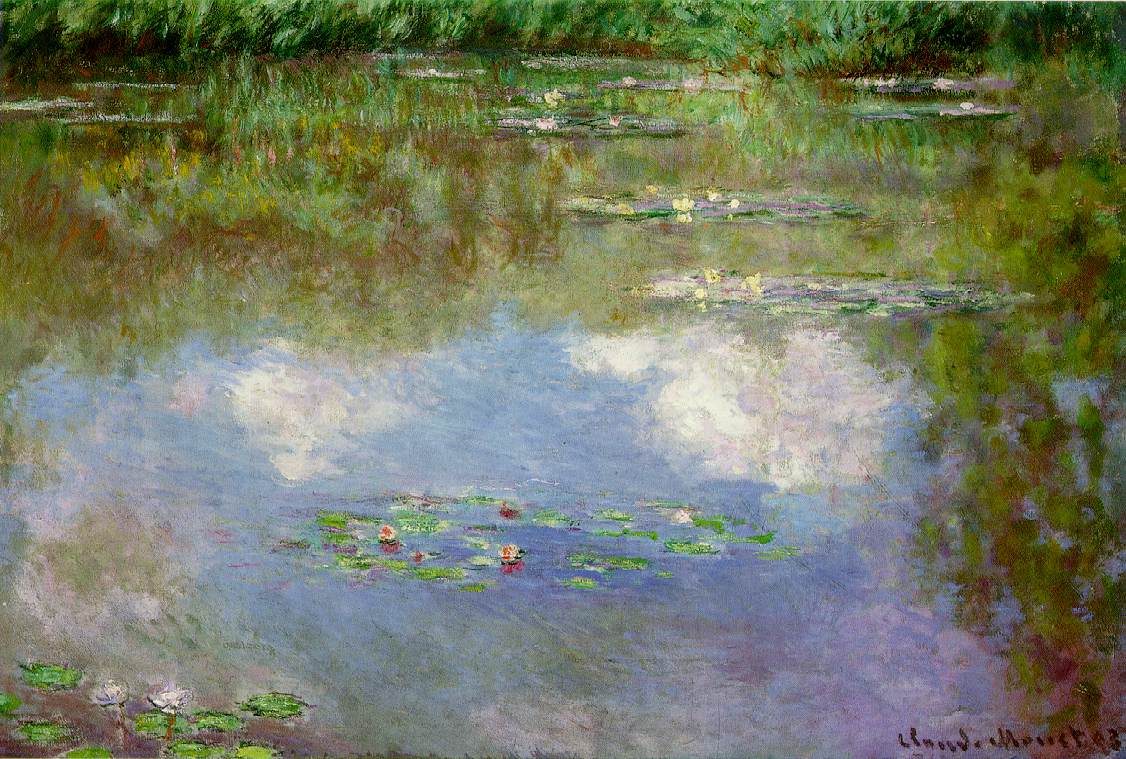
Robert Genn, author of The Painter's Keys, is traveling and visited Musee de L'Orangerie in Paris where the Claude Monet waterlily paintings are on display. He shared this experience:
I've been in these two rooms for so long that my stomach is concerned. A guard has already determined that I'm planning a heist. I'm sure she has alerted her supervisors. And then there's a man who has been in here almost as long as I. He moves from bench to bench. He has a round, friendly face and an honest smile. I find relief in pretending we have met. We talk in hushed, religious tones. He is M. LeClerc, an actuary from Poitiers, in Paris for four days. He thinks I'm an American. I tell him I'm from Canada. "What do you see here?" I ask him.
"I know nothing about art," he tells me, "But every time I come to Paris I enter these rooms. The collection was closed for some six years and Paris was very dull. These are sublime things. They are beyond words or expressions. They cannot be categorized or listed. In winter they take you to spring. They bring my boyhood and my home. Maybe God is in these things. What do I see? I see sadness and I see beauty. What else do we need? What else do we have?" His face is flushed, his eyes moist. "But then, who am I to say?" he asks. "I know nothing about art. Do you have such experiences in Canada?"
7 comments:
Canada, Paris; some things are universal.
I have had the experience of seeing
some of the aterlily paintings in Washington and Kansas City. hey are breathtaking.
"What do you see?" I see a window where our soul comes face to face with Itself and for a wonderful, brief eternity, no words are needed, only silence calling us to recognize our true Self.
It's the quality of the light. How did he do that? I keep asking myself.
Thanks for this beautiful posting. I had one of the most powerful experiences of my life at Musee de L'Orangerie. My post is here,
and records a time of both difficulty and insight.
I spent Friday morning looking through a book on Monet. Kind of weird. I see everyday things made in a way that is beautiful and leads one to take a look at the 'everyday' things again.
Thank you friends, for these reflections: “Canada, Paris; some things are universal...I see a window where our soul comes face to face with Itself and for a wonderful, brief eternity, no words are needed, only silence calling us to recognize our true Self... It's the quality of the light. How did he do that?...I see everyday things made in a way that is beautiful and leads one to take a look at the 'everyday' things again…”
And to Dan for his post on his experience of these very paintings. Dan writes, “I visited the beautiful Impressionist galleries of Musée de l’Orangerie at the Tuileries. The museum housed eight colossal paintings of Nymphéas, water lilies, by Claude Monet. They were, at that time, housed in an underground gallery in two connecting oval rooms. The paintings are very large, some two by six meters. Standing in the middle of the rooms, you become totally immersed in Monet’s vision, with a painting in front, to each side, and behind you. You live in his subtle, all-pervading world of water lilies. You are held spellbound by the vision of a genius, for he had not only created the paintings, he had designed the rooms themselves, requiring them to be opened only after his death.
Standing before the paintings… I could have wept to see those water lilies. I kept walking up close to two of the paintings, Reflets d’arbres and Reflets verts, to see how Monet’s few, almost inconsequential strokes, added up to this or that beautifully unfolding blossom when I stepped back to look again. And behind the many blossoms, the dark waters upon which they floated suddenly became not a few feet deep with shadowed reflections but an opening to the stars, planets, suns and moons, the vastness of the entire universe itself. I knew at that moment that I didn’t know how to look at what had happened to me. I was standing too close to the canvas. I was seeing brush strokes, not the flower, and not what that flower rested upon.
The purpose of my trip to France, I suddenly realized, was to find these paintings, this raw self-knowledge, in the midst of a terribly wounding experience.”
Thank you. Thank you.
These comments prove that Monet is alive and well ! Proof of the afterlife . As for Mr LeClerc he made me giggle, he's just a diamond.
Post a Comment